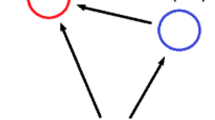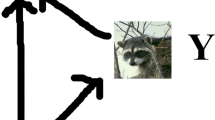Abstract
Intraguild predation systems describe food webs in which an omnivorous predator competes with an intermediate prey for a basal resource. The classical intraguild predation system with Holling type II predation terms has the limitation of not being able to reproduce coexistence between predators in resource-rich environments despite its ubiquity in ecological systems. In this study, adaptive predator-induced and fitness-dependent defense of the intermediate predator is included into the model. In contrast to previous studies, this is done without an artificial bounding term. Numerical bifurcation software is used to show that adaptive defense mechanisms can significantly enhance parameter regimes leading to coexistence. Two different adaptation parameters are distinguished and linked to adaptations under different environmental conditions. The results indicate that the form of the reactivity–accuracy trade-off depends on the state of the environment. Finally, it is shown that an impact of adaptivity on dispersal abilities can considerably change shape and speed of invasion waves on a one-dimensional domain, which is important as those are the main measurable variables when examining data from biological invasions. The results indicate that a locally perfectly adaptive system can be globally (transient) maladaptive.







Similar content being viewed by others
References
Abrams PA (1984) Foraging time optimization and interactions in food webs. Am Nat 124(1):80–96
Abrams PA (2005) Adaptive dynamics’ vs.‘adaptive dynamics. J Evol Biol 18(5):1162–1165
Abrams PA, Allison TD (1982) Complexity, stability, and functional response. Am Nat 119(2):240–249
Abrams PA, Fung SR (2010) Prey persistence and abundance in systems with intraguild predation and type-2 functional responses. J Theor Biol 264(3):1033–1042
Abrams PA, Matsuda H (1997) Prey adaptation as a cause of predator-prey cycles. Evolution 51(6):1742–1750
Aránguiz-Acuña A, Ramos-Jiliberto R, Sarma N, Sarma SS, Bustamante RO, Toledo V (2010) Benefits, costs and reactivity of inducible defences: an experimental test with rotifers. Freshw Biol 55(10):2114–2122
Arim M, Marquet PA (2004) Intraguild predation: a widespread interaction related to species biology. Ecol Lett 7(7):557–564
Banks PB, Dickman CR (2007) Alien predation and the effects of multiple levels of prey naiveté. Trends Ecol Evol 22(5):229–230
Benard MF (2004) Predator-induced phenotypic plasticity in organisms with complex life histories. Annu Rev Ecol Evol Syst 35:651–673
Bengfort M, Malchow H, Hilker FM (2016) The Fokker–Planck law of diffusion and pattern formation in heterogeneous environments. J Math Biol 73(3):683–704
Benson DL, Maini PK, Sherratt JA (1998) Unravelling the Turing bifurcation using spatially varying diffusion coefficients. J Math Biol 37(5):381–417
Chittka L, Skorupski P, Raine NE (2009) Speed-accuracy tradeoffs in animal decision making. Trends Ecol Evol 24(7):400–407
Crank J, Nicolson P (1947) A practical method for numerical evaluation of solutions of partial differential equations of the heat-conduction type. In: Mathematical proceedings of the Cambridge Philosophical Society, vol 43. Cambridge University Press, Cambridge, pp 50–67
Dahl J, Peckarsky BL (2002) Induced morphological defenses in the wild: predator effects on a mayfly, Drunella coloradensis. Ecology 83(6):1620–1634
Daugherty MP, Harmon JP, Briggs CJ (2007) Trophic supplements to intraguild predation. Oikos 116:662–677
Engel K, Tollrian R (2009) Inducible defences as key adaptations for the successful invasion of daphnia lumholtzi in North America? Proc R Soc Lond B Biol Sci 276(1663):1865–1873
Ermentrout B (2002) Simulating, analyzing, and animating dynamical systems: a guide to Xppaut for researchers and students. Society for Industrial and Applied Mathematics, Philadelphia
Frances DN, McCauley SJ (2018) Warming drives higher rates of prey consumption and increases rates of intraguild predation. Oecologia 187(3):585–569
Garay-Narvaez L, Ramos-Jiliberto R (2009) Induced defenses within food webs: the role of community trade-offs, delayed responses, and defense specificity. Ecol Complex 6(3):383–391
Guill C, Drossel B (2008) Emergence of complexity in evolving niche-model food webs. J Theor Biol 251(1):108–120
Hik DS (1995) Does risk of predation influence population dynamics? evidence from cyclic decline of snowshoe hares. Wildl Res 22(1):115–129
Holt RD, Huxel GR (2007) Alternative prey and the dynamics of intraguild predation: theoretical perspectives. Ecology 88(11):2706–2712
Holt RD, Polis GA (1997) A theoretical framework for intraguild predation. Am Nat 149(4):745–764
Kang Y, Wedekin L (2013) Dynamics of a intraguild predation model with generalist or specialist predator. J Math Biol 67(5):1227–1259
Kondoh M (2017) Anti-predator defence and the complexity-stability relationship of food webs. Proc R Soc 274:1617–1624
Kratina P, Hammill E, Anholt B (2010) Stronger inducible defences enhance persistence of intraguild prey. J Anim Ecol 79:993–999
Křivan V, Diehl S (2005) Adaptive omnivory and species coexistence in tri-trophic food webs. Theor Popul Biol 67(2):85–99
Lutscher F, Lewis MA, McCauley E (2006) Effects of heterogeneity on spread and persistence in rivers. Bull Math Biol 68(8):2129–2160
Maron JL, Vilà M (2001) When do herbivores affect plant invasion? evidence for the natural enemies and biotic resistance hypotheses. Oikos 95(3):361–373
Moehrenschlager A, List R, Macdonald DW (2007) Escaping intraguild predation: Mexican kit foxes survive while coyotes and golden eagles kill canadian swift foxes. J Mammal 88(4):1029–1039
Myers RF (1999) Micronesian reef fishes: a field guide for divers and aquarists. Coral Graphics Barrigada, Guam
Mylius SD, Klumpers K, de Roos AM, Persson L (2001) Impact of intraguild predation and stage structure on simple communities along a productivity gradient. Am Nat 158(3):259–276
Polis GA, Myers CA (1989) The ecology and evolution of intraguild predation: potential competitors that eat each other. Annu Rev Ecol Evol Syst 20:297–330
Raak-van den Berg CL, De Lange HJ, Van Lenteren JC (2012) Intraguild predation behaviour of ladybirds in semi-field experiments explains invasion success of Harmonia axyridis. PLoS ONE 7(7):e40681
Ramos-Jiliberto R, Mena-Lorca J, Flores JD, Morales-Álvarez W (2008) Role of inducible defenses in the stability of a tritrophic system. Ecol Complex 5(2):183–192
Randall JE (1967) Food habits of reef fishes of the West Indies. Stud Trop Oceanogr 5:665–847
Rosenzweig ML, MacArthur RH (1963) Graphical representation and stability conditions of predator-prey interactions. Am Nat 97(895):209–223
Sato S, Dixon AFG (2004) Effect of intraguild predation on the survival and development of three species of aphidophagous ladybirds: consequences for invasive species. Agric For Entomol 6(1):21–24
Seiter M, Schausberger P (2015) Maternal intraguild predation risk affects offspring anti-predator behavior and learning in mites. Sci Rep 5:15046
Sentis A, Hemptinne JL, Brodeur J (2013) How functional response and productivity modulate intraguild predation. Ecosphere 4(4):1–14
Urbani P, Ramos-Jiliberto R (2010) Adaptive prey behavior and the dynamics of intraguild predation systems. Ecol Model 221:2628–2633
Van der Stap I, Vos M, Mooij WM (2007) Inducible defenses and rotifer food chain dynamics. Hydrobiologia 593(1):103–110
Verdy A, Amarasekare P (2010) Alternative stable states in communities with intraguild predation. J Theor Biol 262(1):116–128
Verschoor AM, Vos M, van der Stap I (2004) Inducible defences prevent strong population fluctuations in bi- and tritrophic food chains. Ecol Lett 7:1143–1148
Visser AW, Mariani P, Pigolotti S (2012) Adaptive behaviour, tri-trophic food-web stability and damping of chaos. J R Soc Interface 9(71):1373–1380
Wainwright P, Turingan R, Brainerd EL (1995) Functional morphology of pufferfish inflation: mechanism of the buccal pump. Copeia 614–625
Walzer A, Schausberger P (2013) Phenotypic plasticity in anti-intraguild predator strategies: mite larvae adjust their behaviours according to vulnerability and predation risk. Exp Appl Acarol 60(1):95–115
Zhang G, Wang X (2017) Extinction and coexistence of species for a diffusive intraguild predation model with b-d functional response. Discret Contin Dyn Syst Ser B 23(9):3755–3786
Acknowledgements
The author is pleased to acknowledge funding and organization of the VII Southern-Summer School on Mathematical Biology in Brazil by ICTP-SAIFR/IFT-UNESP and R.A. Kraenkel. Early stages of this project were inspired by and benefited a lot from discussions with R.M. Coutinho during this time. Furthermore, the author would like to thank H. Malchow for helpful discussions and proofreading and F.M. Hilker for valuable remarks.
Author information
Authors and Affiliations
Corresponding author
Additional information
Publisher's Note
Springer Nature remains neutral with regard to jurisdictional claims in published maps and institutional affiliations.
Appendices
Appendix A: Jacobian Matrix for the Model Without Adaptation
The Jacobian of the system without adaptation is given by
with the entries
Appendix B: Nullclines of the Model with Adaptation
The nullcline for the model with adaptation can be written as
with
and
with
and
with
and
with
and
for the differential equations modeling the dynamics of the adaptation state, the resource, the IGprey and the IGpredator, respectively.
Rights and permissions
About this article
Cite this article
Köhnke, M.C. Invasion Dynamics in an Intraguild Predation System with Predator-Induced Defense. Bull Math Biol 81, 3754–3777 (2019). https://doi.org/10.1007/s11538-019-00655-4
Received:
Accepted:
Published:
Issue Date:
DOI: https://doi.org/10.1007/s11538-019-00655-4




